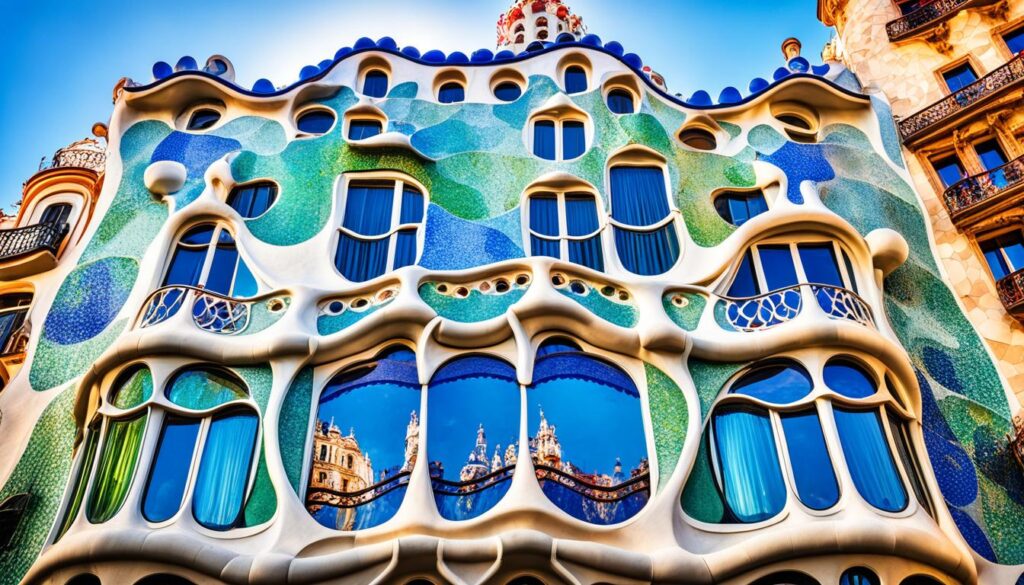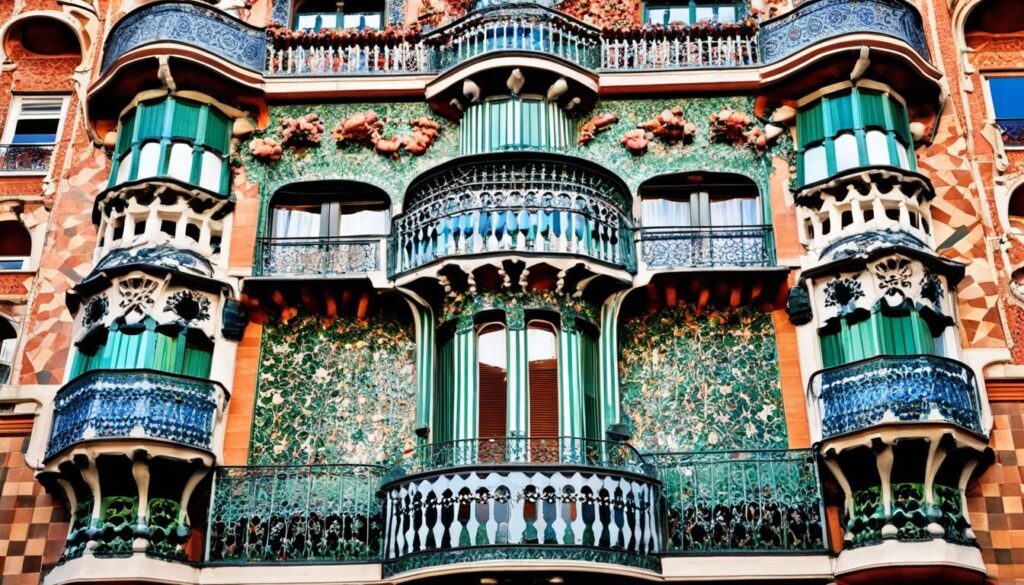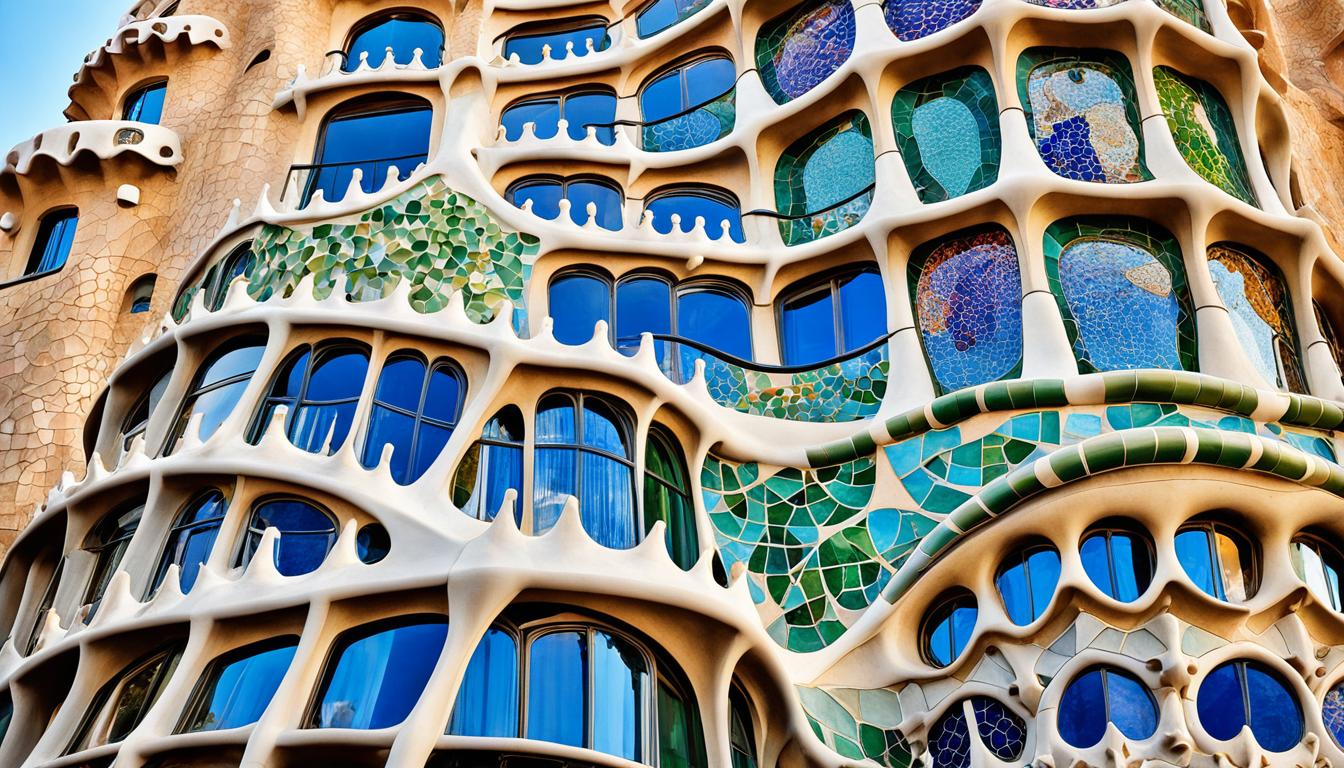Barcelona is famous for its vibrant art and stunning architecture. Antoni Gaudí’s works are at the center of this beauty. His style mixes organic and geometric shapes, with detailed designs and bright colors. This makes his buildings stand out and blend well with nature.
Gaudí’s buildings are known for their unique shapes and vibrant colors. They are a key part of the Art Nouveau movement in Spain, known as Modernisme. Anyone visiting Barcelona should see Gaudí’s creations. They offer a journey into art, history, and stories.
Key Takeaways
- Barcelona is home to several architectural masterpieces designed by renowned architect Antoni Gaudí.
- Gaudí’s unique style blends organic and geometric elements, creating visually stunning structures.
- Gaudí’s works, such as the Sagrada Familia and Park Güell, have made him a renowned figure in the art nouveau movement in Spain.
- Visiting Gaudí’s architectural wonders is a must-do for any traveler to Barcelona.
- Gaudí’s creations are a testament to Barcelona’s rich cultural heritage and artistic legacy.
Antoni Gaudí: The Visionary Architect of Barcelona
Antoni Gaudí was born in 1852 in Reus, Catalonia. He was a Spanish architect with a unique style. His designs were unlike anything his contemporaries were doing. Gaudí drew inspiration from nature, not other architects.
Early Life and Influences
Gaudí got his architecture degree from the Barcelona Higher School of Architecture in 1878, at 26. He had a deep understanding of ruled geometry from the start. This knowledge helped him come up with new ways to build and break free from traditional architecture.
Gaudí’s Unique Artistic Style
Gaudí’s buildings feature natural curved stones, twisted iron sculptures, and shapes that look organic. He believed nature was a divine creation. This style, blending Catalan architecture and Modernisme, made him stand out.
“Nature is the greatest source of inspiration for architecture. I simply try to mimic its forms and patterns in my designs.”
Gaudí’s creative approach made him famous. Seven of his works were named UNESCO World Heritage Sites between 1984 and 2005.
La Sagrada Familia: Gaudi’s Magnum Opus
The Sagrada Familia is Antoni Gaudí’s most famous work and a symbol of Barcelona. It shows how Christian symbols and biblical stories can blend with nature’s beauty. Work started in 1882 and is still going, over 139 years later. Gaudí used the hyperboloid vault to make pillars that look like tree trunks.
The Iconic Basilica’s History and Design
Gaudí took over the Sagrada Familia in 1883 and worked on it for 43 years until his death in 1926. His plan included 18 spires, with 8 finished by 2010. When finished, it will be the world’s tallest church.
The church has three big façades: the Nativity, Passion, and Glory façades. The Nativity façade was finished before a pause in 1935. It shows Gaudí’s style. The Passion façade started in 1954 and has a more serious look.
Symbolic Elements and Artistic Expressions
Inside, the Sagrada Familia has a five-naved basilica with pillars like palm trees. It has stained glass windows and columns that look like tree trunks. This shows Gaudí’s mix of nature, faith, and art.
“The Sagrada Familia is a unique piece of art in the entire history of art.”
https://www.youtube.com/watch?v=XN0VDdtz6Eg
Even though it’s not fully done, the Sagrada Familia is a top spot in Spain. It draws people with its mix of la sagrada familia, gaudi architecture, and modernisme architecture.
Park Güell: A Dreamscape of Modernist Architecture
In the heart of Barcelona, Park Güell stands as a tribute to Antoni Gaudí’s vision. Eusebi Güell, a wealthy industrialist, backed this project. The park is a mix of Gaudí’s modernist style, nature, and art.
The colonnades are a key part of the park. They show off Barcelona’s unique architecture. Gaudí made sure the park and nature work together perfectly.
Gaudí’s old home is now a museum in the park. It’s a place where visitors can see where he lived and worked. Here, you can learn about his creative process.
Modernisme architecture is clear throughout the park. You’ll see organic shapes, detailed tile work, and fun sculptures. These features show Gaudí’s unique style. The park’s mix of nature and architecture makes it a top spot for those visiting park guell.
“Park Güell is a harmonious blend of nature and architecture, a testament to Gaudí’s visionary genius.”
Casa Batlló: A Masterpiece of Catalan Modernism
In Barcelona, Casa Batlló stands out as a key work by Antoni Gaudí. It’s a prime example of Catalan Modernism. Built from 1904 to 1906, it draws visitors with its unique design.
The Iconic Façade and Interior Design
Gaudí’s skill shines in Casa Batlló. The façade’s undulating design, covered in colorful ceramic tiles, seems to move. Balconies look like skulls and bones, and windows are supported by skeletal structures. This makes the building stand out.
Inside, the blend of form and function is striking. Gaudí’s eye for detail is clear in the interior. Here, natural motifs and shapes blend with practical design.
Symbolism and Natural Inspirations
Casa Batlló is more than architecture; it’s a display of Gaudí’s symbolic and naturalistic views. The building’s colors and shapes mirror nature, with the tiles echoing the Mediterranean Sea’s corals.
Gaudí loved to use natural elements in his work. Casa Batlló is a UNESCO World Heritage Site and a top spot in Barcelona, seen by over 1 million people each year.

“Gaudí’s Casa Batlló is a true architectural marvel, where form, function, and symbolism seamlessly converge to create a one-of-a-kind experience.”
| Fact | Value |
|---|---|
| Annual Visitors | 1 million |
| UNESCO World Heritage Site | Yes |
| Best Visit in Europe Nomination | 2023 |
| Construction Period | 1904 – 1906 |
Casa Milá (La Pedrera): A Sculptural Marvel
Casa Milá, also known as La Pedrera, is a true architectural gem by Antoni Gaudí. It’s located at Passeig de Gràcia 92 in Barcelona. This iconic building shows Gaudí’s innovative use of Catalan Modernism architecture.
The Undulating Façade and Rooftop Sculptures
The façade of Casa Milá looks like it was sculpted from the earth. Gaudí used curves and natural forms to create a captivating look. The rooftop has parabolic arches and surreal sculptures, making it dreamlike.
| Architectural Details | Specifications |
|---|---|
| Coordinates | 41°23′43″N 2°09′42″E |
| UNESCO World Heritage Site | Declared in 1984 |
| Completion Date | December 1910 |
| Total Area | 1,323 m2 per floor on a plot of 1,620 m2 |
| Number of Levels | 9 (basement, ground floor, mezzanine, main floor, 4 upper floors, and an attic) |
Casa Milá’s design, without load-bearing walls, allowed for flexible layouts. This was a key part of Gaudí’s innovative style.
Caixa de Catalunya bought Casa Milá in 1986. Since then, it has been preserved and restored. This ensures Gaudí’s genius and Catalan Modernism’s legacy live on.
barcelona gaudi: Other Notable Works
Apart from his famous buildings, Antoni Gaudí also created many other works. These show his skill and growth as an architect. Casa Vicens, his first home project, and Palau Güell, a mix of his styles, are great examples.
Casa Vicens: Gaudí’s First Residential Project
Casa Vicens was built from 1883 to 1885. It’s seen as Gaudí’s big break. The house focuses on the garden and connects indoor and outdoor areas smoothly. It uses natural materials and elements in its design.
Work to restore this Gaudi architecture gem started in 2014. Now, visitors can see its special modernisme architecture and Catalan architecture style.
Palau Güell: A Harmonious Blend of Styles
Eusebi Güell, a rich industrialist, asked Gaudí for Palau Güell. It’s a mix of Gaudí’s styles. The outside is simple, but inside, it’s full of luxury and details. This Gaudi architecture shows how Gaudí mixed practical design with symbolic decorations.
The palace proves Gaudí’s skill in combining modernisme architecture and Catalan architecture ideas.

“Gaudí’s work is considered an exceptional and outstanding contribution to the architectural heritage of modern times, rooted in the cultural and artistic currents of his time in el Modernisme of Catalonia.”
Gaudi’s Influence on Barcelona’s Architecture
Antoni Gaudi’s architectural genius has left a lasting mark on Barcelona. His work has shaped the city’s unique style, known as Modernisme. This style has changed the look of Barcelona.
The Legacy of Modernisme
Gaudi mixed organic forms, geometric shapes, and nature in his work. This mix is key to the Modernisme movement. It has made Barcelona’s buildings famous around the world.
His famous buildings like the Sagrada Familia and Park Güell attract millions. They show why Gaudi is a top architect of the 20th century.
Gaudi also changed building methods to use less material and work faster. His designs, like catenary arches and tree columns, inspire architects today.
The Modernisme style, with its organic forms and bright colors, has changed Barcelona’s architecture. Now, the city’s streets show Gaudi’s unique designs. This mix of old and new is beautiful.
“Gaudi’s work was considered revolutionary both during his lifetime and posthumously for breaking away from traditional architectural practices and drawing inspiration from nature’s perfection.”
Barcelona keeps growing, but Gaudi’s influence is still strong. It shows how innovation, creativity, and nature can last forever.
Exploring Gaudi’s Barcelona: Tips for Visitors
Barcelona is the heart of Antoni Gaudi’s architectural wonders. It’s a city where his unique style shines. Visitors must see the Sagrada Familia and Park Güell. Gaudi’s vision is clear in every corner of the city.
Best Time to Visit and Tour Options
The best time to see barcelona gaudi sites is in spring and fall. The weather is nice, and there are fewer people. There are many guided tours available. These tours focus on the Sagrada Familia, Park Güell, and Casa Batlló. Get Your Guide offers special tours of the Sagrada Familia at night, with only 12 people.
Gaudi Museums and Exhibitions
- The Gaudí House Museum is inside Park Güell. It lets you dive into Gaudi’s life and work.
- Casa Milá, or La Pedrera, has three beautiful apartments. It also shows work by top sculptors.
- Casa Batlló looks amazing from the outside. It’s best to see it at night when it lights up.
There are many gaudi architecture events and exhibitions all year. These events help us appreciate Gaudi’s lasting impact. Gaudi’s works recognized by UNESCO include several sites in Barcelona.
Barcelona’s gaudi museums and tours let you dive into Antoni Gaudi’s world. He was a true genius of modernist architecture.
The Enduring Genius of Antoni Gaudí
Antoni Gaudí’s work has left a lasting impact worldwide. His designs blend nature, religion, and art in a unique way. This has made him one of the most famous architects in history.
Gaudí’s use of organic forms and unique materials has shaped the Modernisme style in Barcelona. His work has inspired many architects and designers over the years.
The Sagrada Familia, Gaudí’s most famous project, shows his vision and lasting effect on Barcelona’s architecture. It’s set to be the tallest structure in Barcelona, 172.5 meters high. Visitors from all over the world are still amazed by it, even though it started in 1882.
Gaudí’s work is known for its innovation, spirituality, and identity. His buildings, like Casa Batlló and Palau Güell, challenge traditional architecture. They show his creativity and vision.
Today, buildings like the Guggenheim Museum in Bilbao and Casa da Música in Porto reflect Gaudí’s influence. They use organic shapes and innovative designs. This proves Gaudí’s lasting impact on antoni gaudi, gaudi architecture, and modernisme architecture.

